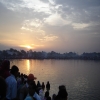
When:
28th Oct
Where:
All Over India
Chhath Puja is more than just a festival; it is a deeply spiritual experience that emphasizes devotion, sacrifice, and gratitude. The dedication of the devotees, who undergo rigorous fasting and offer heartfelt prayers to the Sun God, speaks volumes about the faith that underpins this celebration. Chhath Puja brings families and communities together, strengthening bonds and fostering a sense of belonging. Celebrated with reverence and enthusiasm, this festival is a powerful reminder of the importance of nature, community, and devotion in the pursuit of a fulfilling life.
Chhath Puja is a revered Hindu festival dedicated to Surya Dev (the Sun God) and Chhathi Maiya (the goddess who represents Mother Nature and the power of nurturing life). Celebrated mostly in the states of Bihar, Uttar Pradesh, Jharkhand, and parts of Nepal, Chhath Puja is unique for its rigorous fasting, ceremonial rituals, and reverence for the sun, which sustains all life on Earth. This four-day festival occurs after Diwali, usually in the month of Kartika (October-November), and brings communities together in devotion and harmony.
Significance of Chhath Puja
The Sun God, or Surya, is considered the life-giver and a source of energy and vitality. In Hindu beliefs, he is seen as a powerful deity who bestows health, prosperity, and abundance on those who worship him with sincerity. Chhath Puja is also dedicated to Chhathi Maiya, a goddess associated with the Vedic Goddess Usha, who symbolizes dawn, new beginnings, and the nurturing of life. Devotees pray for the well-being of their family members, prosperity, and the fulfillment of their wishes during Chhath Puja.
The Four-Day Observance of Chhath Puja
Chhath Puja involves a series of observances that span over four days. Each day has a unique significance and is marked by strict rituals and customs, including complete abstinence from food and water, bathing in rivers, and preparing special offerings. Let’s explore each day’s rituals:
Day 1: Nahay Khay
The first day, known as Nahay Khay, involves cleansing rituals. Devotees take a holy bath in rivers or other water bodies to purify themselves. They then prepare traditional vegetarian meals, starting the puja with complete dedication and purity. The food is typically cooked without onion, garlic, or any tamasic (impure) ingredients, signifying simplicity and purity.
Day 2: Lohanda or Kharna
The second day, called Lohanda or Kharna, is a day of strict fasting without water. Devotees break their fast in the evening after offering prasad (sacred food) to the Sun God. The prasad typically includes kheer (a sweet dish made from rice and milk), puri (fried bread), and bananas. This meal is shared with family members, neighbors, and guests, symbolizing communal harmony and sharing.
Day 3: Sandhya Arghya
The third day is considered the most important. Devotees observe a 36-hour fast, which includes refraining from both food and water. In the evening, they gather on riverbanks or other water bodies to offer Sandhya Arghya (evening offerings) to the setting sun. This ceremony involves worshipping with baskets filled with fruits, vegetables, and sweets, symbolizing gratitude to the Sun God. Devotees pray for the health and prosperity of their family members, and the sight of devotees immersed in water, holding their offerings, is a deeply spiritual experience.
Day 4: Usha Arghya
On the final day of Chhath Puja, devotees perform Usha Arghya (morning offerings) at dawn to the rising sun, symbolizing new beginnings and gratitude for life. This ritual represents the conclusion of the festival, where devotees break their fast after the final offering. They seek blessings from the Sun God for a prosperous and healthy life, as well as the fulfillment of their desires.
Preparations and Community Involvement
Chhath Puja is marked by community participation and devotion. In many cities, people organize large gatherings along riverbanks, canals, and ponds where altars are built for the devotees. The air is filled with the sounds of devotional songs, and the atmosphere becomes spiritually charged. Families work together to prepare traditional offerings and arrange for the puja essentials, such as bamboo baskets, clay lamps, and other items. The sense of unity and reverence that Chhath Puja brings to communities is one of the festival's most celebrated aspects.
Unique Aspects of Chhath Puja
Chhath Puja is unique in its observance, as it does not involve idol worship. Instead, it centers on the worship of natural elements like the sun and water, highlighting the intrinsic relationship between humans and nature. The rituals are deeply rooted in simplicity, purity, and self-discipline, and devotees regard the observance of Chhath Puja as an opportunity for personal transformation, inner strength, and spiritual elevation.




